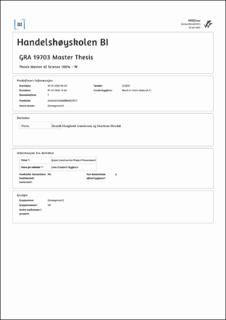Green construction project procurement
Abstract
The construction industry is one of the largest consumers of natural resources, energy, and waste. Procurement in the construction industry has, over several decades, focused on cost minimizing principles with an unwanted side-effect: negative environmental impact from production and transportation of construction materials. Green procurement is by scholars and industry professionals suggested as a solution to tackle environmental challenges caused by traditional procurement, but the Norwegian construction industry struggles with the transition. From our initial meetings with Backe Entreprenør AS, documentation on materials’ environmental impact was pointed out as an underlying challenge.
The purpose of this master thesis was to investigate the current barriers and enablers to green procurement in Norwegian construction projects, especially examining environmental product declarations (EPDs), their obstacles, and their impact on green procurement. Therefore, this thesis address two research questions. To answer these research questions, we have conducted an exploratory case study about Backe Entrepenør AS with abductive reasoning. The data collection consists primarily of interviews and meetings with industry professionals.
We have identified several important barriers and enablers to green procurement in Norwegian construction projects. Our findings reveal that the most significant barriers are “lack of documentation on material’s environmental impact” and “lack of a common unit and standardization of information.” Further, the most prominent enablers: “Standardization, implementation, and use of environmental and reusable data,” “increased demand and stricter legal requirements for choosing environmental products and materials,” and “inter-organizational collaboration, learning, and knowledge transfers.” Our conclusion elaborates that EPD implementation and utilization of EPDs are prerequisites for green procurement. Without sufficient documentation on the materials´ environmental impact, it is not possible to determine whether a material decision is environmentally friendly or not. However, EPD must be seen in conjunction with the materials’ performance specifications.
Description
Masteroppgave(MSc) in Master of Science in Business, Logistics, operations and supply chain management - Handelshøyskolen BI, 2022
